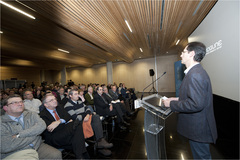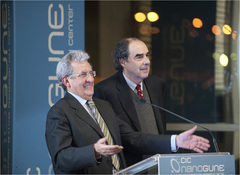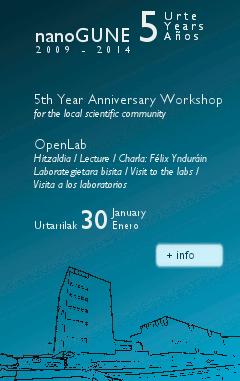Great response marking nanoGUNE’s 5th year anniversary
The fact that the properties of materials vary on the nanoscale opens up endless applications that are beginning to be part of our daily lives. These are concepts that may escape our understanding but which have been handled at nanoGUNE on a daily basis for the last five years. Scientific work which the students, teachers, engineers, doctors, architects, economists, retirees, housewives, etc. who came to nanoGUNE on its 5th year anniversary had the chance to get to know first-hand with the help of the center’s researchers.

During the center’s early days “what we wanted to do was carve ourselves out a niche and make ourselves known through our contributions,” as nanoGUNE’s Director General Jose Maria Pitarke asserted. Five years have passed since then, and “the assessment is very positive and very encouraging. We have exceeded all expectations,” pointed out Pitarke at the start of the open day to celebrate the center’s 5th year anniversary. “Not only have we set up a infrastructure of the highest standard, we have also managed to draw a large number of Ikerbasque researchers, all highly recognized in their respective fields,” he stressed. Pitarke insisted that it is necessary to go on transmitting knowledge to companies. “That’s what we’ve done until now and it is the great challenge in store for us in the future,” he said.
The scientific workshop took place throughout the morning; in it the speakers Niek van Hulst (ICFO, Barcelona), Víctor Muñoz (CSIC, Madrid), Kirsten von Bergmann (University of Hamburg) and José María de Teresa (CSIC, Zaragoza) covered subjects like protein folding, nanophotonics, spintronics and nanomagnetism.
Open day

NanoGUNE’s chairman, Pedro Miguel Etxenike, officially opened the afternoon session of the open day. He took advantage of the opportunity to express his satisfaction for the degree of development of a project he has always believed in. “Because in a matter of a few years I saw that nanoGUNE had turned into a top international center in research, able to attract the cream of creative talent, produce cutting-edge science, transmit knowledge to the production base and create new companies. Something that is very difficult to achieve here or anywhere else,” he pointed out. “The success is due to collective effort,” so he expressed thanks for the work of nanoGUNE’s Board of Trustees, the Scientific Committee, the managers, researchers and technicians. Etxenike highlighted how essential the continued support of the Government of the Basque Autonomous Community is and described its long-term, strategic vision as decisive for setting up a framework enabling creativity to flourish. Such policies need to continue to provide the project with stability. Etxenike sincerely thanked the center’s Director General Jose Maria Pitarke for his work. “Starting from scratch he has managed to create premises and equipment that are state-of-the-art worldwide, draw talent, design and maintain the strategic lines as well as contribute to the industry of our country. All this can only be achieved by building the confidence of many people, and to do this the talent, determination and untiring work are necessary conditions, but insufficient on their own. What is also needed is solid human experience and generous, integrating leadership.” Etxenike described Pitarke as the great architect of nanoGUNE’s success.
After that, Félix Ynduráin, Professor in the Department of Condensed Matter Physics of the Autonomous University of Madrid, gave a talk on “Nanoscience and future energy technologies.” How are we going to meet future energy demand? What role does nanoscience play? These are just some of the questions Ynduráin tackled in his talk. After analyzing the evolution in energy consumption worldwide, and the perspectives on its future evolution, he focused on the need for new developments to meet future energy demands. In particular, he discussed some specific examples of the role played by nanoscience in nuclear and photovoltaic energy, the use of hydrogen, energy and CO2 storage, electrical power transportation, etc. “The development of new materials on a nanoscale, as well as methods for characterizing and manipulating them, create a fresh paradigm for the development of new, revolutionary energy technologies,” stressed Ynduráin.
After the talk came the moment to visit the very core of nanoGUNE. This initiative was a resounding success, as venue capacity had been reached some days previously. Those who went on the visit had the chance to see the clean room, a microscope unique worldwide that allows electronic, mechanical and optical properties to be measured on an atomic scale, an electron microscope with which they saw graphene produced by Graphenea, nanoGUNE’s first start-up, and a whole series of technologies spread around various laboratories free of vibrations, electromagnetic interference, noise and dirt. An all-round trip to the nanoworld within reach of members of the general public.

